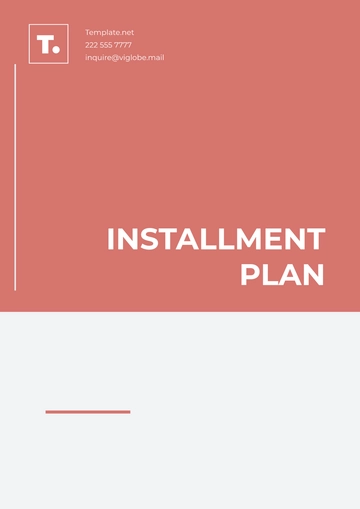Free Blank Clothing Financial Plan

I. EXECUTIVE SUMMARY
Company: [YOUR COMPANY NAME]
Prepared By: [YOUR NAME]
Mission Statement:
Clearly define the company's purpose, vision, and target market.
Business Description:
Provide a concise description of the business.
II. COMPANY OVERVIEW
A. Business Objectives
[SPECIFIC OBJECTIVE 1]
[SPECIFIC OBJECTIVE 2]
[SPECIFIC OBJECTIVE 3]
B. Business Model
Describe the business structure and explain the revenue sources.
C. Product Line Overview
Provide a summary of the product lines, their features, and the unique value propositions offered to the market.
III. INDUSTRY AND MARKET ANALYSIS
A. Industry Overview
Outline the overall clothing and apparel industry landscape, including recent trends, growth potential, and market drivers.
B. Target Market
Define the target customer demographics, and any other relevant characteristics.
C. Competitive Analysis
Identify direct competitors, market position, and the competitive advantages held by [YOUR COMPANY NAME].
D. Market Trends
List relevant current trends impacting the fashion industry, such as sustainability, digital fashion, and athleisure.
IV. MARKETING STRATEGY
A. Branding and Positioning
Explain how [YOUR COMPANY NAME] will position itself in the market through branding, logo design, color scheme, and voice.
B. Pricing Strategy
Detail the pricing approach, ensuring competitiveness while maintaining profitability. Include cost-based, value-based, or competition-based pricing as applicable.
C. Sales and Distribution Channels
Describe where and how products will be sold, such as online store, third-party retailers, and brick-and-mortar locations.
D. Promotional Plan
List promotional strategies, such as social media, email marketing, influencer partnerships, and seasonal sales.
V. OPERATIONS PLAN
A. Location and Facilities
Specify the physical location, if applicable, and any warehousing or distribution facilities.
B. Production Process
Outline the sourcing strategy for materials, manufacturing partners, and production timelines.
C. Supply Chain Management
Detail the supply chain, including inventory management, logistics, and fulfillment.
D. Staffing Plan
Provide an overview of the team, including key roles such as designer, production manager, marketing manager, and projected hiring plans.
VI. FINANCIAL PLAN
A. Revenue Streams
Outline projected revenue sources, including direct sales, wholesale, licensed products, and any other income streams.
B. Start-Up Costs
List the initial costs, such as equipment, inventory, legal fees, rent, and marketing.
Expense Category | Estimated Cost (USD) |
|---|---|
Equipment | $[AMOUNT] |
Initial Inventory | $[AMOUNT] |
Legal and Permits | $[AMOUNT] |
Marketing | $[AMOUNT] |
Total Start-Up Costs | $[AMOUNT] |
C. Sales Forecast
Provide sales projections for the first three years. Example:
Year | Q1 | Q2 | Q3 | Q4 | Total |
|---|---|---|---|---|---|
Year 1 | $[AMOUNT] | $[AMOUNT] | $[AMOUNT] | $[AMOUNT] | $[AMOUNT] |
Year 2 | $[AMOUNT] | $[AMOUNT] | $[AMOUNT] | $[AMOUNT] | $[AMOUNT] |
Year 3 | $[AMOUNT] | $[AMOUNT] | $[AMOUNT] | $[AMOUNT] | $[AMOUNT] |
D. Break-Even Analysis
Provide a break-even analysis to show how much sales revenue is required to cover fixed and variable costs.
E. Profit and Loss Projection
Estimate the profit and loss for each year for the first three years.
F. Funding Requirements
List funding sources needed for start-up and expansion, along with the expected Return on Investment (ROI).
VII. APPENDICES
Appendix A: Additional Financial Statements
Appendix B: Market Research Data
Appendix C: Legal and Operational Documents
Appendix D: Product Line Details
This Clothing Financial Plan will serve as a living document, to be regularly updated as business needs and market conditions evolve. It provides a comprehensive framework to guide [YOUR COMPANY NAME] in its financial decision-making and strategic planning.
- 100% Customizable, free editor
- Access 1 Million+ Templates, photo’s & graphics
- Download or share as a template
- Click and replace photos, graphics, text, backgrounds
- Resize, crop, AI write & more
- Access advanced editor
Plan your fashion business finances effectively with Template.net’s Blank Clothing Financial Plan Template. Fully customizable and editable, this template allows you to track your financial projections with ease. Editable in our Ai Editor Tool, you can tailor it to your business needs and take control of your clothing brand’s financial success.
You may also like
- Finance Plan
- Construction Plan
- Sales Plan
- Development Plan
- Career Plan
- Budget Plan
- HR Plan
- Education Plan
- Transition Plan
- Work Plan
- Training Plan
- Communication Plan
- Operation Plan
- Health And Safety Plan
- Strategy Plan
- Professional Development Plan
- Advertising Plan
- Risk Management Plan
- Restaurant Plan
- School Plan
- Nursing Home Patient Care Plan
- Nursing Care Plan
- Plan Event
- Startup Plan
- Social Media Plan
- Staffing Plan
- Annual Plan
- Content Plan
- Payment Plan
- Implementation Plan
- Hotel Plan
- Workout Plan
- Accounting Plan
- Campaign Plan
- Essay Plan
- 30 60 90 Day Plan
- Research Plan
- Recruitment Plan
- 90 Day Plan
- Quarterly Plan
- Emergency Plan
- 5 Year Plan
- Gym Plan
- Personal Plan
- IT and Software Plan
- Treatment Plan
- Real Estate Plan
- Law Firm Plan
- Healthcare Plan
- Improvement Plan
- Media Plan
- 5 Year Business Plan
- Learning Plan
- Marketing Campaign Plan
- Travel Agency Plan
- Cleaning Services Plan
- Interior Design Plan
- Performance Plan
- PR Plan
- Birth Plan
- Life Plan
- SEO Plan
- Disaster Recovery Plan
- Continuity Plan
- Launch Plan
- Legal Plan
- Behavior Plan
- Performance Improvement Plan
- Salon Plan
- Security Plan
- Security Management Plan
- Employee Development Plan
- Quality Plan
- Service Improvement Plan
- Growth Plan
- Incident Response Plan
- Basketball Plan
- Emergency Action Plan
- Product Launch Plan
- Spa Plan
- Employee Training Plan
- Data Analysis Plan
- Employee Action Plan
- Territory Plan
- Audit Plan
- Classroom Plan
- Activity Plan
- Parenting Plan
- Care Plan
- Project Execution Plan
- Exercise Plan
- Internship Plan
- Software Development Plan
- Continuous Improvement Plan
- Leave Plan
- 90 Day Sales Plan
- Advertising Agency Plan
- Employee Transition Plan
- Smart Action Plan
- Workplace Safety Plan
- Behavior Change Plan
- Contingency Plan
- Continuity of Operations Plan
- Health Plan
- Quality Control Plan
- Self Plan
- Sports Development Plan
- Change Management Plan
- Ecommerce Plan
- Personal Financial Plan
- Process Improvement Plan
- 30-60-90 Day Sales Plan
- Crisis Management Plan
- Engagement Plan
- Execution Plan
- Pandemic Plan
- Quality Assurance Plan
- Service Continuity Plan
- Agile Project Plan
- Fundraising Plan
- Job Transition Plan
- Asset Maintenance Plan
- Maintenance Plan
- Software Test Plan
- Staff Training and Development Plan
- 3 Year Plan
- Brand Activation Plan
- Release Plan
- Resource Plan
- Risk Mitigation Plan
- Teacher Plan
- 30 60 90 Day Plan for New Manager
- Food Safety Plan
- Food Truck Plan
- Hiring Plan
- Quality Management Plan
- Wellness Plan
- Behavior Intervention Plan
- Bonus Plan
- Investment Plan
- Maternity Leave Plan
- Pandemic Response Plan
- Succession Planning
- Coaching Plan
- Configuration Management Plan
- Remote Work Plan
- Self Care Plan
- Teaching Plan
- 100-Day Plan
- HACCP Plan
- Student Plan
- Sustainability Plan
- 30 60 90 Day Plan for Interview
- Access Plan
- Site Specific Safety Plan





























